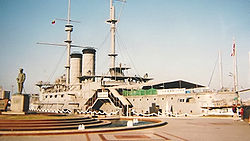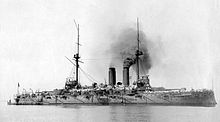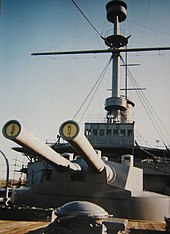Mikasa (ship)
|
||||||||||||||||
|
||||||||||||||||
|
||||||||||||||||
|
||||||||||||||||
The Mikasa ( Japanese 三 笠 ) is a ship of the line of the Japanese Navy and was the flagship of Admiral Tōgō Heihachirō during the Russo-Japanese War of 1904/1905. It was named after Mount Mikasa in the city of Nara and is now the last surviving battleship from the pre-dreadnought era.
background
After the end of the first Sino-Japanese War (1894–1895) and the forced return of the Liadong Peninsula to China by Russia , Japan began building a powerful army to prepare for any further conflicts. Among other things, Japan announced a 10-year plan to build up its naval forces. The core of the plan was the construction of six battleships and six armored cruisers . All six ships of the line were ordered in Great Britain. The last of these battleships was the Mikasa , which was ordered from the British Vickers shipyard in 1898 for delivery for 1902. Construction took three years and cost 880,000 pounds (8.8 million yen ). Previously, in 1897 and 1898, the sister ships Fuji and Yashima were delivered by the Thames Ironworks in Blackwall (London) and Armstrong-Whitworth in Elswick near Newcastle upon Tyne , respectively , followed in 1900 and 1901 by the sister ships Shikishima and Hatsuse from the same builders as the third and fifth ship . The fourth ship to be delivered in 1900 was the Asahi , built by John Brown & Company .
At the time of delivery, the Mikasa was state-of-the-art ( standard ship of the line ). Ten days after its commissioning, the Royal Navy took over the Bulwark, the fourth ship of the Formidable class. The ship built for Japan was on par with the Formidable class and slightly superior to the older Majestic class. Great Britain supported Japan not only politically since 1895 against France, Russia and Germany, but also militarily with these modern ships. The collaboration culminated in the Anglo-Japanese Alliance in 1902 .
Mission history
Attack on Port Arthur
The Russo-Japanese War began with preemptive strikes by the Imperial Japanese Navy against the Russian Pacific Squadron in Port Arthur and Chemulpo . Admiral Tōgō's plan for the United Fleet was directed against Port Arthur with the 1st Division, which, in addition to the flagship Mikasa with the Hatsuse , the Shikishima , the Asahi , the Fuji and the Yashima, included all six ships of the line in the new construction program, and the 2nd Division which consisted of the armored cruisers Iwate , Azuma , Izumo , Yakumo and Tokiwa . These main battle ships were supported by the cruisers Kasagi , Chitose , Takasago and Yoshino and 15 destroyers and about 20 smaller torpedo boats .
On the night of February 9, 1904, ten destroyers attacked the Russian naval base at Port Arthur, where seven ships of the line and six cruisers were moored. The first four destroyers to arrive hit the Pallada amidships, which caught fire, and the Retwisan in the forecastle. A total of 16 torpedoes were fired, but only one more hit was scored, which, however, put the modern ship of the line Zessarewitsch out of action. The two best ships of the line and the protected cruiser Pallada were out of action for weeks.
In the morning, the four cruisers under Vice Admiral Dewa Shigeto cleared up the Russian base and Dewa recommended an artillery attack because he thought the Russians were disorganized. When the fleet called, the cruiser Bojarin was at sea and fired at the Mikasa at the greatest possible distance before heading back into port. The Russian ships turned on steam, but only the Novik actually ran out and launched a torpedo attack. The Japanese concentrated the fire of their heavy artillery on the coastal batteries. The central artillery of the ships of the line and the armored cruisers fired at the Russian squadron and damaged the ships of the line Petropavlovsk , Poltava and only slightly the Pobeda and the Sevastopol . The armored cruisers Bajan and Novik , Diana and Askold were also hit harder .
Among the Japanese ships, Mikasa , Fuji , Hatsuse , Shikishima , Azuma , Iwate , Yakumo and Takasago were hit and had 53 staff failures, while the Russians had 128 failures, 22 of them dead. Togo broke off the fight because he found the Russians ready to fight.
The Mikasa sided with the 1st Division of the Japanese fleet the backup service against the Russian Port Arthur Squadron, covering the actions of the lighter units, such as the action against the Russian guard destroyer on March 10, in which the Russians the destroyer Stereguschtschi lost. During the advance and retreat of Makarov on April 13, the Russian flagship Petropavlovsk got into a minefield, received three mine hits and exploded. 635 men were killed with the commander. The Pobeda also received a mine hit.
On May 15, the Japanese ships of the line Yashima and Hatsuse ran into a Russian minefield off Port Arthur and were lost with around 700 deaths.
Further Russian naval advances took place on June 23, when the Sevastopol was hit by a mine on the march back, and on July 24, 1904. When the latter marched back , the bayan ran into a mine, but reached Port Arthur. She was the only larger warship in the repair, as the squadron on 10 August 1904 under Rear Admiral Wilgelm Vitgeft tried the Japanese blockade towards Vladivostok to break, leading to the defeat in the Battle of the Yellow Sea led, in the Withöft on the Russian battleship Tsesarevich fell.
Sea battle in the Yellow Sea
The Russians tried to break out of the Yellow Sea with the ships of the line Zessarewitsch , Retwisan , Pobeda , Peresvet , Sevastopol and Poltava and the cruisers Askold , Pallada , Diana and Novik and eight destroyers. The Japanese fleet under the command of Admiral Togo included the ships of the line Mikasa , Asahi , Fuji and Shikishima , the armored cruisers Nisshin and Kasuga , eight cruisers and 18 destroyers and 30 torpedo boats.
The main force of the Japanese fleet initially blocked the Russian route along the Shandong peninsula . At around 1 p.m., both sides opened fire; after about an hour, Admiral Withoft finally managed to break out. Admiral Togo, whose flagship had received a large number of hits and whose radio system had failed, decided to look for a more favorable combat situation and tried to run past the slower Russian squadron. Driving on a parallel course, both sides began another firefight at 4:20 p.m. at a distance of about eight to nine kilometers, in which considerable damage was achieved on both sides.
At 6:00 p.m., when the battle was far from over and the Russian fleet could still count on an escape as darkness fell, Admiral Withoft was killed by a shrapnel on the bridge of the Zessarevich . About twelve minutes later another shell struck the bridge, which killed both the commander and almost all of the bridge personnel. Due to the damaged steering gear, the Zessarewitsch began to drive in circles, heavily heeling. The following ships tried, ignorant of the events on the flagship, to follow, so that the Russian order of battle disintegrated when the Zessarevich finally ran back into its own combat formation. Fortunately for the Russians, Admiral Togo broke off the battle at this point because of the darkness, significant hits, especially on the Mikasa , the failure of a number of guns (instead of 16 only 11 305 mm guns ready for use) and the onset of a lack of ammunition and continued a little East. He didn't want to risk losing another ship of the line. During the night he let his destroyers and torpedo boats carry out attacks on the Russian ships, which, however, could be repulsed on the Russian side without major losses.
Most of the Russian squadron (five ships of the line, one cruiser and three destroyers) returned to Port Arthur. The other units were scattered in the dark and went to other ports. The badly damaged Russian battleship Tsesarevich reached with the three destroyers Besposchtschadny , Besschumny , Besstraschny to Qingdao , where the ships of the German authorities were interned. The Nowik also ran into Tsingtau, but ran out again to reach Vladivostok according to the original plan. It was brought before Sakhalin by the Japanese and sank at Korsakow itself. The Askold ran to Shanghai , where later the destroyer Grozowoi also arrived, while the Diana ran to Saigon , where she was interned.
The Mikasa received about 20 hits on August 10, 1904, and its rear 305 mm turret was knocked out by being hit. 125 men of the crew failed. Immediately in the battle, no ship was lost on either side. During the night the destroyer Burny ran aground near Cape Shantung and was a total loss. Except for the Nowik off Sakhalin , the other Russian ships were no longer used at sea during the war. The Japanese ships of the line, which besides the Fuji suffered considerable damage, and the damaged armored cruiser Yagumo were repaired and fought at Tsushima.
Historical meaning
During the naval battle of Tsushima , the Mikasa led the Japanese association into the decisive battle, which is considered to be one of the most momentous naval battles in military history. The Second Pacific Squadron of the Imperial Russian Navy under Admiral Zinovi Petrovich Roschestvensky was almost completely destroyed; 21 of the 38 Russian ships involved were sunk, seven were captured and six interned in neutral ports. Over 4,500 Russian sailors were killed and more than 6,000 were captured. The Japanese side had only 116 dead and lost three torpedo boats.
The performance of the Japanese fleet was analyzed by western observers and played a decisive role in the further development of the naval forces. In particular, the finding that sea battles can be decided at distances of over 5 nm led to the development of the dreadnoughts .
Another story
One week after the signing of the Portsmouth Peace Treaty on September 5, which marked the end of the Russo-Japanese War, the Mikasa sank after an ammunition explosion on September 12, 1905 in the port of the city of Sasebo . The ship was badly damaged by the explosion and 339 men of the 935 crew were killed. Another 343 men were injured.
The ship was later salvaged from the eleven meter deep harbor basin, put back into service in 1907 and used as a coastal defense ship until 1921. However, with the development of newer warships, it quickly lost its importance and was finally decommissioned in 1921. In 1923 the Mikasa was exhibited as a museum ship in Yokosuka and was a destination for many visitors until 1945.
After the defeat in World War II , the ship was confiscated by the American occupiers, who dismantled all armament. The ship was in extremely poor condition in the period that followed. In 1948 the ship was returned to the Mayor of Yokosuka City; an association for the preservation of monuments took care of the ship from then on. The USA supported the rehabilitation financially and with the direct involvement of Admiral Chester W. Nimitz . The restoration, which brought the ship to 1902 with the help of original plans by Vickers, was completed on May 27, 1961 and had cost 180 million yen by then.
A tourist brochure handed out to visitors to the Mikasa describes it as one of the “three great historic warships”, along with the Victory in Portsmouth (UK) and the Constitution in Boston (USA).
literature
- Robert A. Burt: Japanese Battleships 1897-1945 . Arms and Armor Press, ISBN 0-85368-758-7
- Christopher Howe: The origins of Japanese trade supremacy. Development and Technology in Asia from 1540 to the Pacific War. ISBN 0-226-35485-7 .
- Conway Marine (Ed.): The Battleship Dreadnought. ISBN 0-85177-895-X .
Web links
- Mikasa picture gallery ( memento from April 23, 2007 in the Internet Archive )
Coordinates: 35 ° 17 ′ 6 ″ N , 139 ° 40 ′ 27 ″ E







